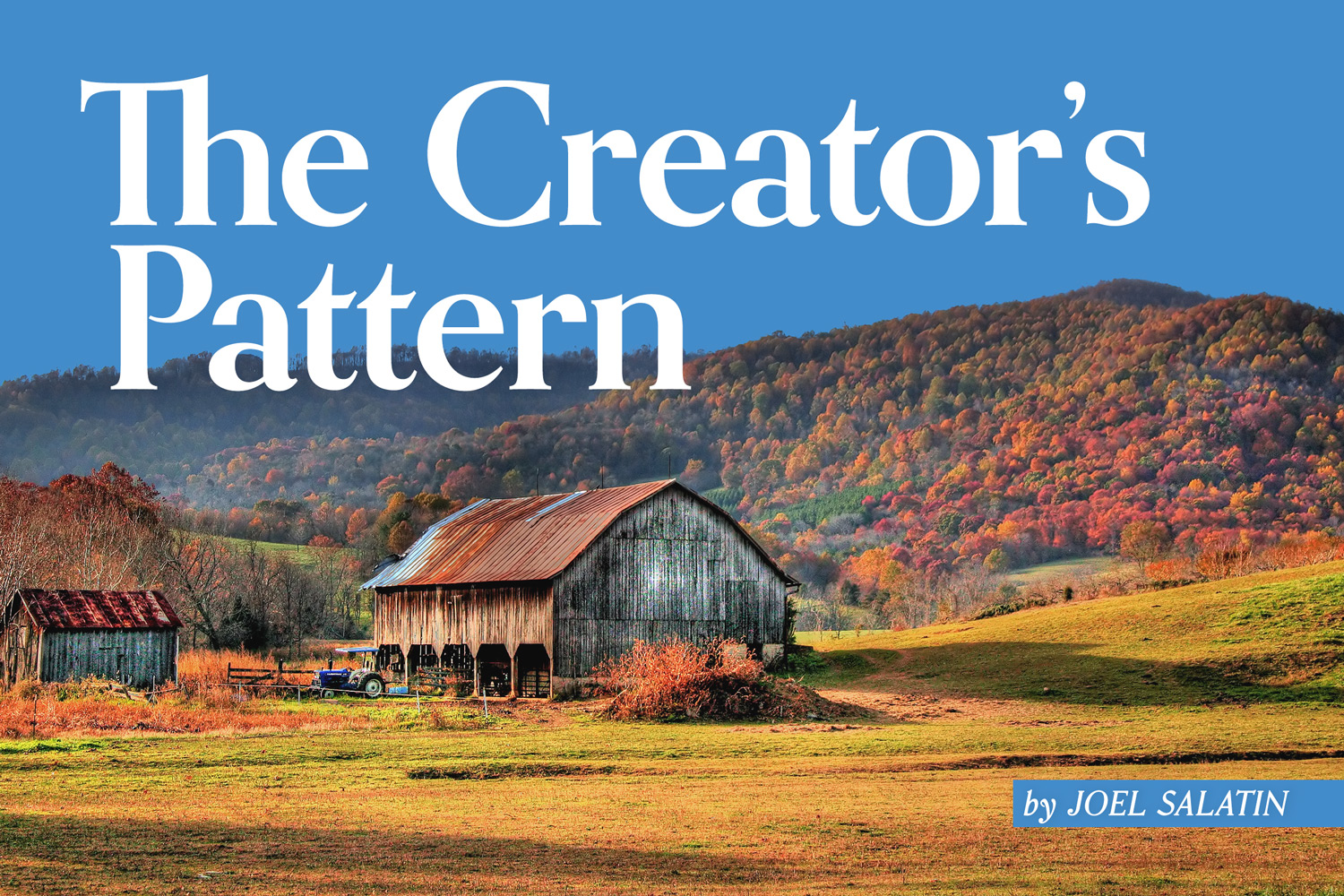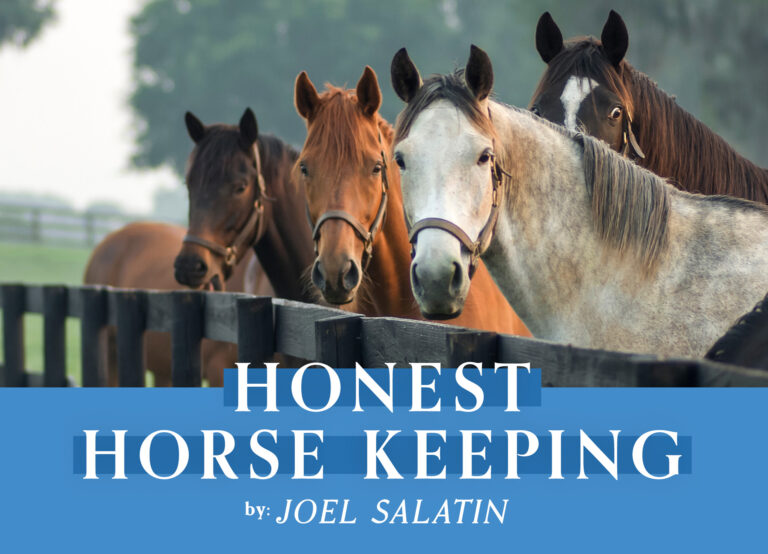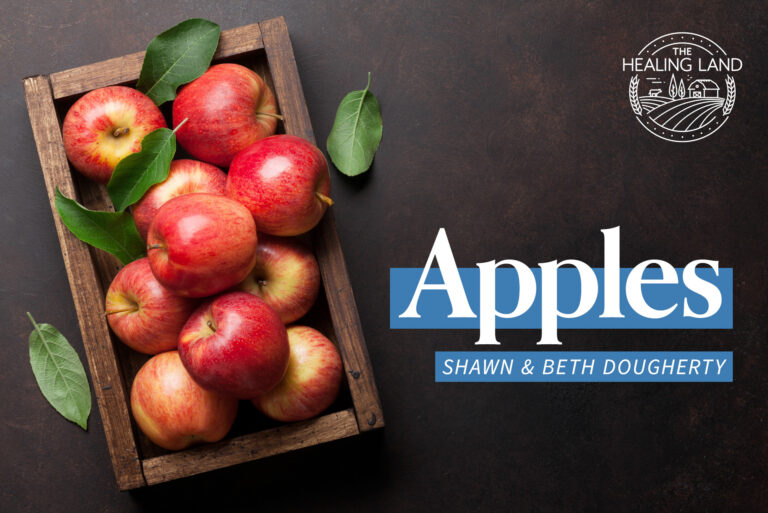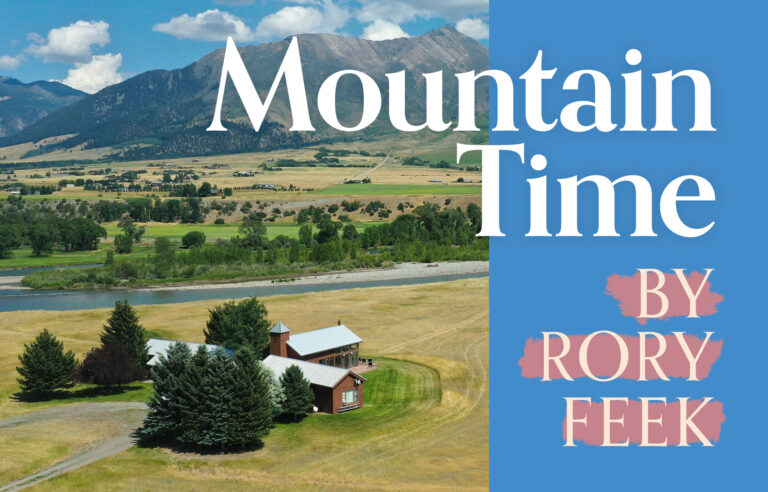The Creator’s Pattern
By Joel Salatin, Plain Values
In 1961 as our family looked out over this newly-acquired farm property with its rocks, gullies, and weeds, we needed a roadmap to healing. In our imagination, we could see fertile fields, filled-in gullies, and soil-covered rocks, but how to get there was intimidating. Our redemption project seemed impossible.
My dad contacted both private and public (government) agriculture experts to receive as broad a range of counsel as possible. Every advisor recommended borrowing more money, planting corn, building silos, grazing the woods, and feeding the soil chemical fertilizers.
My grandfather was a charter subscriber to Rodale’s Organic Gardening and Farming magazine when it debuted in the late 1940s and drank the non-chemical Kool-aid. He had a quarter-acre garden surrounded by T-trellis Concord grapes, an octagonal chicken house, and a large compost pile. Because of this mindset growing up, Dad viewed chemicals of all types—remember, DDT was culturally considered God’s gift to humanity—as a drug addiction. To get the same kick, you needed either more volume or more concentration; either option required more expenses.
As an economist, Dad knew that trying to grow commodities with a narrow margin on a small farm didn’t make sense. Undifferentiated commodities always reward the biggest players because the margins are slim. Competing in that arithmetic requires lots of bushels or pounds in order to generate enough income at low margins.
While he didn’t know all the answers, he knew that the answers from expert agricultural advisors were not correct. Those models had eroded the soil, hurt the forest, and brought on poverty. Over the next decade, he began a series of experiments that today form the basis for our land redemption recipe. Interestingly, it coincides precisely with general patterns in nature. God designed nature to be abundant, not scarce.
1) Perennials Are Key
Annuals do not build soil; perennials do. Because perennials depend on food stocks stored in the root mass savings account, the energy flows from the plant into the soil. Annuals, on the other hand, depend on a seed (grain) or fruit containing seeds to propagate and therefore extract energy from the soil.
For agronomist readers, this may sound too simplistic, but it’s generally correct. The energy flow in perennials is down; the energy flow in annuals is up. That’s why cropland, over time, impoverishes soil while perennial pasture improves soil. Pre-chemical fertilizers, 7-year rotations with 3 years of annuals and 4 years of perennial pasture used building years to balance out extraction years. Indeed, draft power created a bit of an insurance policy over this extraction because all draft animals are some permutation of an herbivore, requiring forages rather than grains. Before the industrial revolution, all farms required one-third of their acreage in perennial pasture to provide their energy via draft power.
Petroleum and non-animal energy breached this historic boundary to cultivation and annuals, greatly accelerating soil erosion and degeneration. Realizing that all the best soils on the planet developed under perennials meant we wanted as much of our land in perennial forages as possible. Perennials, like on the native American prairies, convert more sunlight into biomass more efficiently than trees, shrubs, or annuals.
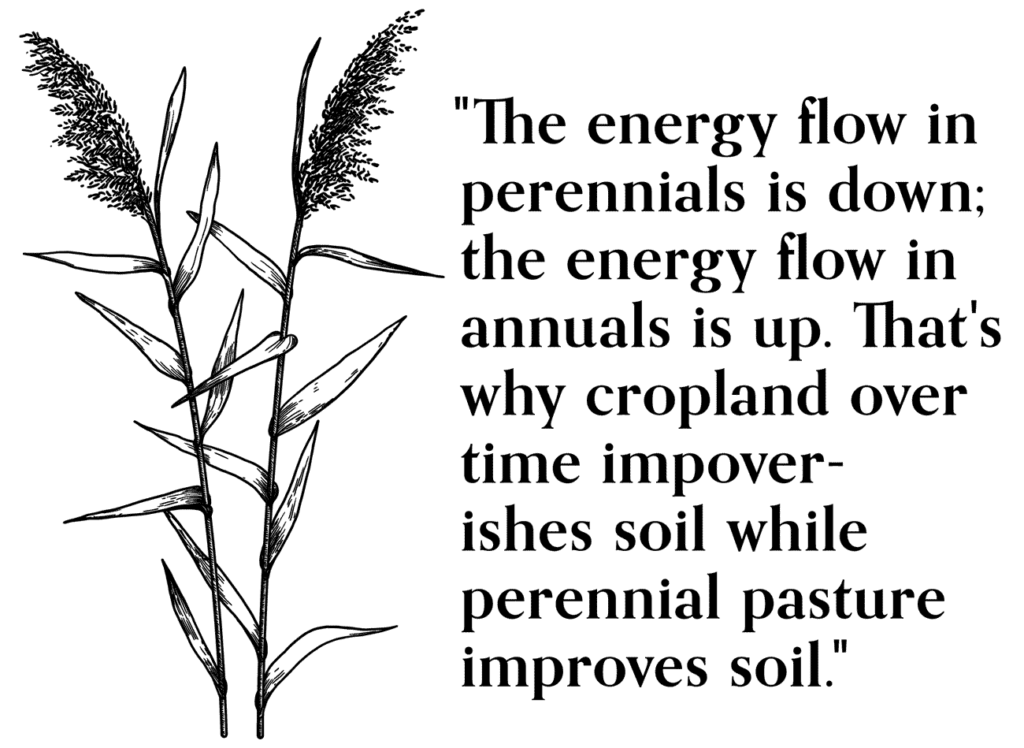
2) Animals Move
This seems like a silly axiom, but we live in a culture that does not believe animals need to move. The industrial paradigm assumes farm animals should be locked up in large buildings, confined to tiny quarters, devoid of sunlight, and congested with fecal particulate. Docking pig tails, debeaking chickens, and other techniques all developed as a result of stress in these disrespectful conditions.
While we couldn’t duplicate the migratory choreography of large herds and flocks that we see in nature, we could innovate mobile control, shelter, water, and feeding systems. Thus Dad developed a workable mobile electric fencing system; eventually, today’s more dependable and lightweight systems gradually replaced our early clunky systems. When I was home from college, I spent one month hand digging some 250 post holes to install our permanent electric fence grid around all the fields. This identified usable fields and protected forestal and riparian areas.
Moving the animals around required water in all the fields. This progressed from Vs into creeks to hauling to piston-pumping by hand to battery pumps to today’s 8-mile network of gravity-fed black plastic water lines fed by permaculture-style high-terrain ponds.
Mobile shelters using shade cloth for cattle, pigs, and turkeys but solid roofing for chickens offered comfort on hot days and placed manure meticulously where we wanted it rather than losing it under trees.
3) Carbon Economy
God’s design does not use chemical fertilizer to feed the soil; it utilizes biomass decomposition. Manure, fallen leaves, lodged grass—all of this is carbonaceous organic material that falls onto the soil surface as food for the billions of bacteria, fungi, nematodes, and protozoa living there. These decomposers and recyclers feast on this physical sunlight (plants) and, in turn, offer the next generation of plants minerals, vitamins, and hormones.
Perhaps the most important community in our sphere of influence is not the human but the community of beings in the soil beneath our feet. Ultimately, everything we build, use, or fabricate depends completely on this soil’s biological community. Unfortunately, this community is never considered when writing business plans and negotiating trade deals in today’s frantic and frenzied economy.
How could we encourage this community? With carbon. We purchased a chipper and began converting poor quality, diseased, and fence-line encroaching trees into decomposable pieces. Today we use some 25 tractor-trailer loads of chips to build a carbonaceous diaper under the livestock when they are indoors during the winter. This includes chickens, rabbits, and pigs in hoop houses, as well as cattle in sheltered sheds. Under the cattle, this static carbon sponge can build up to 4 feet deep.
The cows tromp out the oxygen, creating an anaerobic pack. As we add chips throughout the winter, we put in about 80 pounds of whole-shelled corn per cubic yard. That ferments in the pile to provide the salary for the pigs. In the spring, when the cows go back out to pasture, the pigs aerate those carbonaceous diapers seeking the fermented corn and convert everything to aerobic compost. That’s our fertilizer.
4) Multi-everything
Mono-cropping and single-species farming fly in the face of God’s diversity design. Just like a variety of gifts encourages balance and functionality in a local fellowship group, so a variety of animals, plants, and enterprises creates stability in an ecosystem. A farm is an ecosystem.
A related nuance is complex symbiotic relationships between species. Companion planting in the garden utilizes this idea. Animals do too. Birds following herbivores are one of the most common symbiotic relationships in nature. As a result, we follow the cows with laying hens in an Eggmobile. It’s not new; it’s as old as creation.
This includes buildings that serve multiple functions. Hoop houses for pigs, rabbits, and laying hens in the winter double up as vegetable production in the spring, summer, and fall. The pole shed that stores hay also houses cows in the winter, pigs for ‘pigaerator’ compost in the spring, and rabbits in the summer. The various animals in proximity keep pathogens confused and stifled.
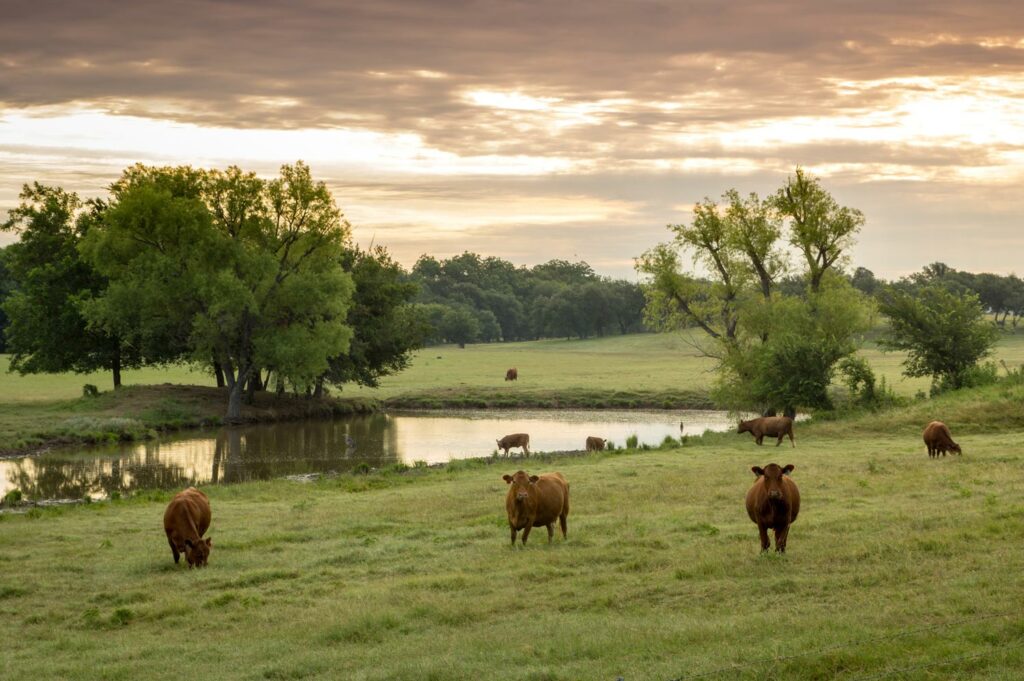
5) Water From Ponds
Rather than digging wells, we mimic beavers. North America was 8 percent water 500 years ago, the product of 200 million beavers. Today, North America is less than 4 percent water. Rather than viewing water as a drainage problem, we need to view water as a hydration challenge.
Louis Bromfield, writing about his Malabar Farm in Ohio during the 1950s, said the answer to flooding on the Mississippi was not big Army Corps of Engineers projects on the river; it was millions of small farm ponds on high ground. He said water needs to be saved before it builds up volume and velocity, and he was exactly right. Part of humanity’s mandate as stewards is to build forgiveness into the landscape. We will always have rain excesses and rain shortfalls. The beavers helped ameliorate these cycles, but with modern machinery, we can do better by locating surface runoff impoundments in normally dry valleys. This protects neighbors downstream from flooding and offers the balm of water to the community during droughts.
Since one-third of all raindrops run off because they come too fast or the soil is already saturated, saving that on high ground is one of the most redemptive things we can do for a landscape. Every time we get some extra money, we invest it in building another pond.
6) Neighborhood Commerce
Known as local food systems, selling to folks nearby creates regional food security. Virtually every community in America imports 93 percent of its food. On average, 4 calories of energy are necessary to move every calorie of food to our dinner tables because the average morsel travels 1,500 miles between farm and plate.
That means eaters don’t see how their food is produced, which diminishes accountability in the food chain. It also means farmers feel no connection or responsibility to the people they’re feeding.
Longer distance selling is not a sin, but the backbone of any food system should be regional and not global. A certain degree of distance commerce has always existed, like the spice trade. But the majority should be regional, not just for accountability but also for security and stability in the food chain.
Over the years, we found success by joining those notorious middlemen condemned by average farmers for making all the money. By adding processor, marketer, and distributor to our producer job description, we owned more of the value chain, enabling us to make a full-time living on a small farm. In future columns, we’ll flesh out all these principles; that will take years. But these are the key points of the template that did indeed build soil up over the rocks, fill in gullies, and create a profitable small farm. Stay tuned.
This article was published in the October 2021 issue of Plain Values Magazine. If you want the latest stories every month, subscribe to the magazine at plainvalues.com. As a special thanks, get 10% off your subscription with the code “GAB23”!
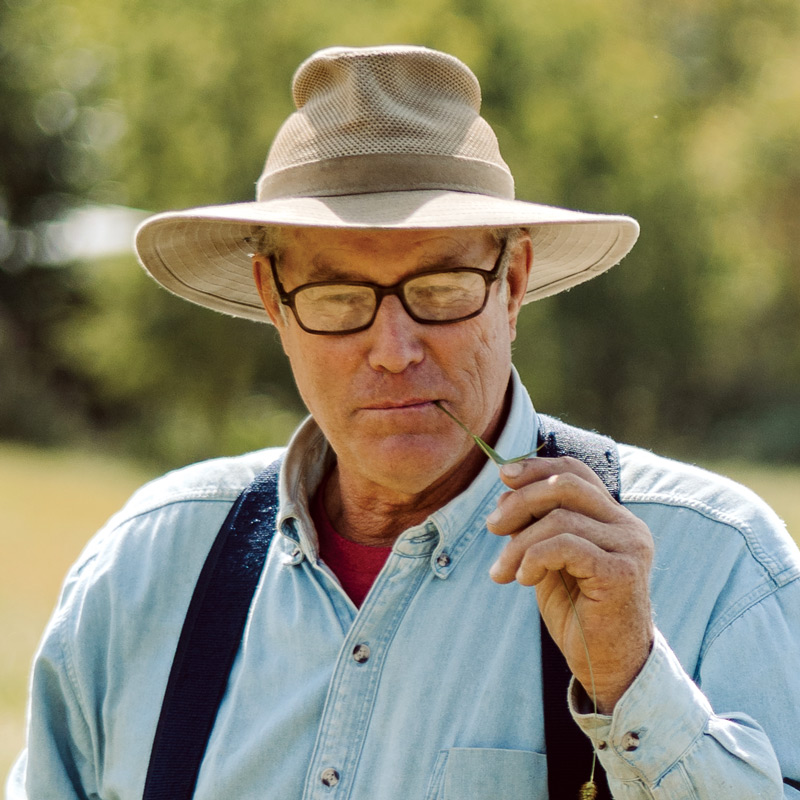
Joel co-owns, with his family, Polyface Farm in Swoope, Virginia. When he’s not on the road speaking, he’s at home on the farm, keeping the callouses on his hands and dirt under his fingernails, mentoring young people, inspiring visitors, and promoting local, regenerative food and farming systems.


